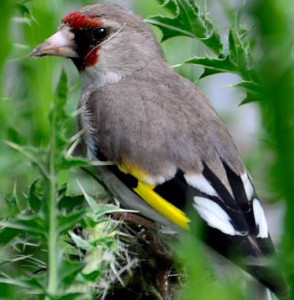
Carduelis carduelis (European goldfinch)
Carduelis carduelis, commonly known as the European Goldfinch, is a striking and colorful bird that can be spotted in the Great Himalayan National Park (GHNP), especially during the spring and summer months. With its distinctive red face, yellow wing patches, and black-and-white plumage, the European Goldfinch is a delight for birdwatchers and nature enthusiasts.
The European Goldfinch is highly adaptable and can thrive in a variety of habitats, including forests, meadows, and agricultural lands, which makes it a common sight throughout GHNP. Its cheerful calls and energetic flight make it easy to spot in the park’s diverse environments.
Habitat and Distribution in GHNP
In the Great Himalayan National Park, the European Goldfinch is typically found at elevations between 1,200 and 2,500 meters, where it favors wooded areas, shrubs, and open spaces. These birds are often seen in scrubland near forest edges, as well as in meadowlands where seeds and grasses provide a significant part of their diet.
The Tirthan and Sainj valleys within GHNP offer prime habitat for this species, which is especially abundant during the warmer months when food resources are plentiful.
Behavior and Diet
The European Goldfinch is primarily a seed-eating bird, known for its ability to feed on a wide range of plant species. It feeds on thistles, sunflowers, and various grasses, using its conical beak to extract seeds. It is also known to forage on dandelions, aster plants, and weed seeds.
These birds are social and often form small groups during foraging, though they tend to disperse into pairs during the breeding season. Their energetic flight, frequent chirps, and distinctive calls make them easy to identify when moving through the park’s vegetation.
| Common name | European Goldfinch |
| Scientific name | Carduelis carduelis |
| Family | Fringillinae |
| Description | It has red face and black and yellow wings with white tertial markings. Head pattern distinct in larger major, which has been reported as vagrant.Resident and winter visitor .Breeds (2400-3900m) and in winter migrates below 1500m.. |
Conservation Significance
The European Goldfinch is a species of Least Concern, with stable populations across Europe and parts of Asia. In GHNP, it benefits from the park’s diverse habitats, which provide ample food sources and nesting sites. By maintaining the park’s natural vegetation and protecting its ecosystems, GHNP plays a key role in ensuring the health of the European Goldfinch population.



